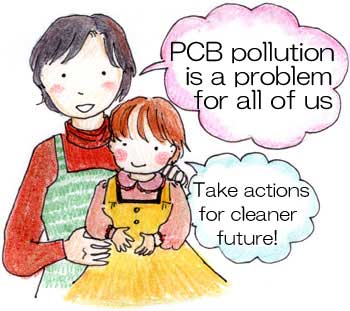









 |
 |
| Why were PCB
used and why should they be prohibited? |
 |
|
|

Figure of the chemical structure of PCBs |
Convenient features of PCBs have led to worldwide use
The formal name of PCBs is polychlorinated biphenyls. They
are substances made up of molecules that consist of 2 benzene
rings (biphenyl) with chlorines. Different PCBs have different
numbers and locations of chlorines and these are called isomers.
There are 209 PCBs in all, and 14 of those with planar structures
are called coplanar PCBs. Every isomer has different physical
characteristics and toxicity. When toxicity is evaluated,
these differences are important factors.
PCBs have notable features, such as heat resistance, insulation,
and chemical stability. These useful characteristics of PCBs
are not found in other substances, and therefore PCBs were
widely used in industrial applications. PCBs, however, are
very dangerous chemicals.
In products containing PCBs, the quantity of isomers contained
and their patterns differ one from another, even if they have
the same brand name, for example, Arocrol 1221, 1232 and 1242.
Depending on the product, PCBs come in different forms, sometimes
as colorless oils and sometimes in powder form.
Features of PCBs
 |
 |
 |
GOOD
|
 |
BAD |
 |
 |
 |
Insulation
|
 |
Hard to biodegrade |
Hard to volatilize
|
 |
Remains in environment |
Hard to burn
|
 |
Accumulate in
fat tissues
of living things |
Insoluble in
water but
soluble in organic solvents
|
 |
Suspected carcinogen
and
have various toxicities |
 |
 |
 |
|
Adverse effects of PCBs ? The Kanemi Yusho Incident as a
starting point
In 1968, the Kanemi Yusho Incident occurred in Kitakyushu
City, Japan. In this incident, "Kanemi rice oil"
produced by Kanemi Warehouse was contaminated with PCBs. PCBs
were used as a heating medium and were being circulated through
a coil. Somehow, a pinhole-sized crack appeared in the coil
and PCBs leaked out, contaminating the cooking oil.
Contaminated oil was sold in the marketplace and people who
consumed it fell ill. Victims were afflicted with various
health problems, such as skin pigmentation effects, an increased
fetal death rate, and chlorine acne. Even before the harm
to people was revealed, chickens had been affected. Hens were
fed chicken feed contaminated with the oil and a massive death
occurred; however, these deaths were not considered a serious
issue. If they had been taken seriously, then perhaps the
Kanemi Yusho Incident would not have happened.
The number of victims of the Kanemi Yusho Incident exceeded
14,000. More than 30 years have passed, yet victims are still
suffering from their injuries. It turned out later that poly-chloro-dibenzofuran
(PCDF), a dioxin, was also contained in the contaminated oils.
Finally, in 2002, the Japanese Government admitted that the
injuries were caused by PCBs, as well as dioxin. After the
Kanemi Yusho Incident, people began to realize the toxicity
of PCBs and the movements to forbid PCBs spread globally.
Various toxicities of PCBs
When people are exposed to a lot of PCBs at one time, such
as in accidents, a rash will appear on the skin immediately.
In cases of very high concentration exposure, effects include
pigmentation changes, chlorine acne, irritation of mucous
membranes, increased blood serum triglycerides, deterioration
of the liver, and disruption of the immune system.
PCBs can cause such acute influences, but they are also known
to cause chronic symptoms. In animal experiments, tumors have
been found in the liver, and PCBs are suspected to be carcinogenic
in humans. IARC (International Agency for Research on Cancer)
has classified PCBs as substances that are "Probably carcinogenic
to human: 2A." The National Toxicology Program classifies
PCBs as reasonably anticipated to be human carcinogenic.
Carcinogenicity of PCBs
 |
| International
Agency for Research on Cancer (IARC) |
 |
 |
 |
1
|
Carcinogenic to humans
|
 |
| 2A |
Probably carcinogenic to humans
|
 |
| 2B |
Possibly carcinogenic to humans
|
 |
| 3 |
Not classifiable as to carcinogenicity
in humans
|
 |
| 4 |
Probably not carcinogenic
to humans
|
 |
 |
| National Toxicology Program
(NTP) |
 |
 |
 |
 |
Known to be Human Carcinogens
|
 |
 |
Reasonably Anticipated to
be Human Carcinogens
|
 |
|
Toxic influences other than cancer
PCBs are currently suspected of being endocrine disruptors,
which reinforce or block the work of hormones in our bodies,
unbalancing our immune and nervous systems. It appears that
disruption of the immune system may lead to pneumonia or
viral illnesses and disruption of the nervous system may
influence children's developmental processes. One report
has found a possible link between lower intelligence quotients
(IQ) in children born to parents who consumed PCB polluted
fish from the Great Lakes. The IQs of victims of oil contamination
in Taiwan have also been found to be low and behavior disorders
have also been observed.
One type of PCBs, called coplanar-PCBs, has a plane-like
structure, similar to dioxin, and shows the same toxicity
as dioxin, including reproductive/developmental impacts.
Miscarriages, reduced weight after birth, and teratogenicity,
such as uranoschisis, have been reported. Furthermore, these
PCBs are suspected to cause endometriosis.
PCBs exhibit very toxic features, and since they do not
decompose easily, once they are emitted into the environment,
they remain for a long time. Therefore, this is a serious
concern for us, as well as for future generations that may
suffer the effects of PCB pollution. If PCB pollution continues,
then what will happen to the children and other creatures
on Earth that inhabit the future environment and society?
Beginning now, we have to stop PCB pollution.

|
|
|
